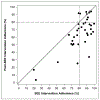Glaucoma Medication Adherence 1 Year after the Support, Educate, Empower Personalized Glaucoma Coaching Program
- PMID: 35953021
- PMCID: PMC10246914
- DOI: 10.1016/j.ogla.2022.08.001
Glaucoma Medication Adherence 1 Year after the Support, Educate, Empower Personalized Glaucoma Coaching Program
Abstract
Purpose: To assess the efficacy of the Support, Educate, Empower (SEE) glaucoma coaching program on medication adherence among poorly adherent patients with glaucoma for 12 months after cessation of the intervention.
Design: Uncontrolled intervention study with a pre-post design.
Participants: The SEE cohort was recruited from the University of Michigan and included patients with glaucoma aged ≥ 40 years, taking ≥ 1 medication, who self-reported poor adherence. Electronic medication monitoring of those who completed the program continued for up to 1 year after the coaching intervention.
Methods: Adherence was monitored electronically (AdhereTech) during the 7-month program and 12-month follow-up period. Adherence was the percentage of doses taken on time. Participants were censored for surgery, change in glaucoma medications, or adherence monitor disuse. The SEE program included automated medication reminders, 3 in-person motivational interviewing-based counseling sessions with a glaucoma coach, and 5 phone calls with the coach for between-session support. There was no contact between the study team and participants during the 12-month follow-up after program cessation. Baseline participant characteristics were summarized with descriptive statistics. Paired t tests and Wilcoxon signed rank tests were used to investigate significant changes in monthly adherence during follow-up.
Main outcome measures: Change in electronically monitored medication adherence over the 12 months following the conclusion of the SEE program.
Results: Of 48 participants, 39 (81%) completed the SEE program and continued electronic medication monitoring for up to 1 year after program cessation. The mean age of the participants was 64 years (standard deviation [SD], 10); of the 39 participants, 56% were male, 49% were Black, and 44% were White. The mean length of follow-up was 284 days (SD, 110; range, 41-365 days). Censoring occurred in 18 (56%) participants. The mean adherence during the follow-up period was 67% (SD, 22%). This was significantly lower than the adherence during the SEE program (mean, 81%; SD, 18%; P < 0.0001) but significantly higher than the baseline preprogram adherence (mean, 60%; SD, 18%; P = 0.0393). The largest monthly losses occurred at months 1 (mean, 7%; P = 0.0001) and 4 (mean, 6%; P = 0.0077).
Conclusions: Glaucoma medication adherence decreased significantly in the year after cessation of the SEE coaching program but remained significantly higher than baseline adherence. To maintain excellent long-term medication adherence, intermittent reinforcement sessions may be necessary.
Keywords: Glaucoma; Long-term follow-up; Medication adherence.
Copyright © 2022 American Academy of Ophthalmology. Published by Elsevier Inc. All rights reserved.
Conflict of interest statement
Figures
References
-
- Bourne RRA, Stevens GA, White RA, et al. Causes of vision loss worldwide, 1990-2010: a systematic analysis. Lancet Glob Health 2013;1:e339–349. - PubMed
-
- Olthoff CMG, Schouten JSAG, van de Borne BW, Webers CAB. Noncompliance with ocular hypotensive treatment in patients with glaucoma or ocular hypertension an evidence-based review. Ophthalmology 2005;112:953–961. - PubMed
-
- Rossi GCM, Pasinetti GM, Scudeller L, et al. Do adherence rates and glaucomatous visual field progression correlate? Eur J Ophthalmol 2011;21:410–414. - PubMed
Publication types
MeSH terms
Substances
Grants and funding
LinkOut - more resources
Full Text Sources
Medical



